Porkfish
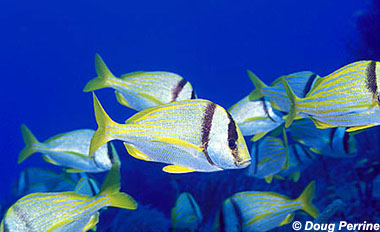
Anisotremus virginicus
This small fish gets its name from the grunting noise it makes by grinding its teeth together like other grunts do. It has a tall, flat body, with yellow and blue-silver stripes and two black bars running downwards over its eyes and just behind its cheeks. Yellow also highlights its face and fins, including its deeply forked caudal (tail) fin. This nocturnal schooling fish can grow to 15 inches long and 2 pounds, but usually is found much smaller. In the ocean it is curious towards humans, and it is a popular public aquarium fish.
Order – Perciformes
Family – Haemulidae
Genus – Anisotremus
Species – virginicus
Common Names
English language common names are porkfish, Atlantic porkfish, and paragrate grunt. Other common names include arroz con coco (Spanish), bandera spano (Papiamento), bonakanaal (Papiamento), burro catalina (Spanish), canario (Spanish), catalineata (Spanish), kuroobidai (Japanese), lippu rondeau (French), luszczyk wirginski (Polish), palriot (French), roncador-listado-americano (Portuguese), rondeau (French), salema (Portuguese), spaansevlag (Dutch), and svinfisk (Norwegian/Swedish).
Importance to Humans
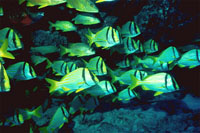
Porkfish are of minor commercial fisheries value, however they are considered a good gamefish. Human consumption of the flesh of porkfish has been linked to ciguatera poisoning. Specimens are also collected for display in public show aquaria. In its natural habitat, porkfish are easily approached by divers.
Conservation
The porkfish is not listed as endangered or vulnerable with the World Conservation Union (IUCN). The IUCN is a global union of states, governmental agencies, and non-governmental organizations in a partnership that assesses the conservation status of species.
> Check the status of the porkfish at the IUCN website.
Geographical Distribution
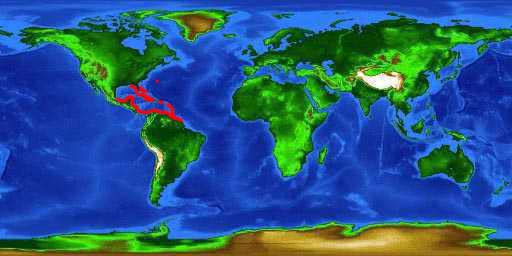
Porkfish occur in the western Atlantic Ocean from Florida south to Brazil, including the Gulf of Mexico and the Caribbean Sea as well as the Bahamas. It has also been introduced to waters off Bermuda.
Habitat
Inhabiting shallow inshore waters over reefs and rocky bottoms, the porkfish is found at depths of 6-65 feet (2-20 m). It is nocturnal and often travels in large schools, occasionally swimming with white grunts. Porkfish make a grunting sound, common to all grunts, by rubbing their teeth together.
Biology
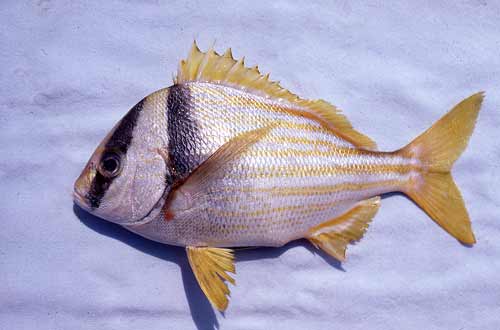
Distinctive Features
The porkfish is a deep-bodied grunt with a blunt snout and thick lips. It has a higher dorsal profile than most other grunts. The caudal fin is notched. The mouth is small and positioned low on the head.
Coloration
The body has yellow and silvery-blue stripes, and two black bars. One bar runs diagonally from above the eye to the mouth while the other is more vertical, beginning at the anterior edge of the dorsal fin to the base of the pectoral fin. The fins are yellow. Juvenile porkfish have no black bars, but instead have a large dark blotch near the base of the caudal fin. Two black stripes run horizontally through the midbody and back. The head is a brilliant yellow.
The porkfish is the only grunt occurring in the Atlantic Ocean with this yellow coloration and two black stripes. It is closely related to the burrito grunt (Anisotremus interruptus) from the Pacific Ocean. This pair is referred to as germinate species, believed to have been separated millions of years ago by the isthmus of Panama.
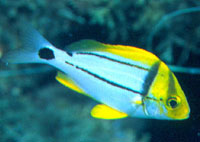
Size, Age, and Growth
Porkfish reach a maximum length of 15 inches (38 cm) and weight of 2 pounds (9 g). This fish commonly weighs only 4 ounces (113 g).
Dentition
Although the porkfish is a grunt, it lacks canines on the jaws and vomer teeth. Teeth are located on the pharyngeal bone of the jaw.
Food Habits
Invertebrates such as mollusks, echinoderms, crustaceans, and worms are preyed upon by nocturnally feeding adult porkfish. Juvenile porkfish pick parasites from the skin and scales of other species of fish, and are considered “cleaners”.
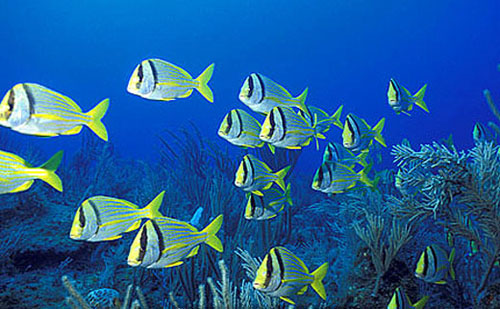
Reproduction
There is very little known about spawning and larval development of the porkfish. The larvae are similar in appearance to other sparids, but have a distinctive caudal fin spot. The second dorsal and anal fins are the first of the fins to begin development, a common pattern among perciform fishes.Parasites
Parasites of the porkfish include cestode larvae found in the gills and copepods found within the operculum. A dinoflagellate, Oodinium ocellatum, has been observed in the kidney and internal tissues of this fish.
Predators
Snappers, groupers, sharks and other large piscivores are potential predators of the porkfish.
Taxonomy
This fish was originally named Sparus virginicus in 1758 by Carl Linnaeus, a Swedish naturalist. It was later renamed Anisotremus virginicus (Linnaeus 1758), the currently accepted scientific name. The genus name, Anisotremus, is derived from the Greek “anisos” meaning unequal and “trema” / “-atos” meaning hole. There are no known synonyms used in previous scientific literature referring to this fish.
Prepared by: Cathleen Bester